Fear, the FBI, and Academia
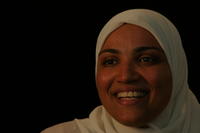 When the FBI arrested two Pakistani-Americans as suspected terrorists in Lodi, CA this June, the small farming town became the center of national and international media attention. But news media has not shown the extent to which the FBI has followed, monitored, and intimidated the greater Muslim American community there, including families who have lived and farmed in Lodi for generations.
When the FBI arrested two Pakistani-Americans as suspected terrorists in Lodi, CA this June, the small farming town became the center of national and international media attention. But news media has not shown the extent to which the FBI has followed, monitored, and intimidated the greater Muslim American community there, including families who have lived and farmed in Lodi for generations.
VEENA DUBAL, my classmate at Stanford, detailed the Lodi case in her article, The FBI Witch-Hunt in Lodi, California. Read her article for the entire story about misinformation, media hysteria, fear and the FBI.
We decided to travel to Sacramento Valley to find out more. We spent the afternoon hearing stories in the regional office of the Council on American-Islamic Relations (CAIR). We met DINA EL-NAKHAL (pictured above), communications director, who grew up in the area and went to UC Davis:
“Muslim Americans in Lodi feel terrorized. The FBI follows their children, questions them at night, and holds men for interrogations. I spoke at a “Know Your Rights” session for the community. Afterward, a woman came up to me, tears rolling down her cheek. With what little English she had, she said, ‘I didn’t know that the FBI interrogation was voluntary. If I had, I would have never told my son to go. He never came back that night. It’s all my fault.'”
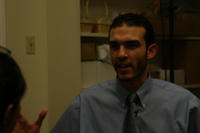
These Lodi accounts came soon after our visit to Stanford University, where two Stanford professors shared with us reflections that cast light on these stories.
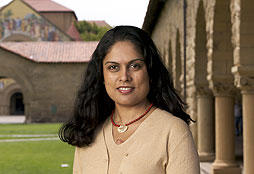 JAYASHRI SRIKANTIAH (pictured) is a professor and director of the Immigrants’ Rights Clinic at Stanford Law School. I first met Jayashri when she was a legal director at ACLU in San Francisco, where we worked together briefly on a project to document stories of those deported after INS special registration.
JAYASHRI SRIKANTIAH (pictured) is a professor and director of the Immigrants’ Rights Clinic at Stanford Law School. I first met Jayashri when she was a legal director at ACLU in San Francisco, where we worked together briefly on a project to document stories of those deported after INS special registration.
In our conversation, Jayashri detailed the state policies and programs since 9/11 that have targeted non-citizens, from detentions and deportations to the PATRIOT ACT.
“The administration has said that this is not a war against Islam, but actions speak louder than words. Its actions have consistently targeted Muslims, Arabs, and non-citizens. A war on terror is a war on immigrants.”
In response to two New York legislators who supported a bill to mandate racial profiling in NY subways after the London bombings, Jayashri said:
“Racial profiling has never prevented a terrorist attack. What’s more, it gives the green light for prejudice among the public. Instead law enforcement should build relationships with these very communities in order to fight terrorism effectively.”
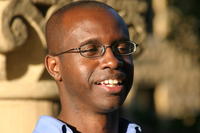 After Jayashri’s legal analsyis, we heard from social psychology in an interview with JOSEPH BROWN (pictured), now Dean of Student Affairs at Stanford University. Joseph advised me on my honors thesis about post-9/11 prejudice, together with Linda Hess, when I was a senior at Stanford. We had experimented together in applying social psychology theories to the prejudice that took place after 9/11.
After Jayashri’s legal analsyis, we heard from social psychology in an interview with JOSEPH BROWN (pictured), now Dean of Student Affairs at Stanford University. Joseph advised me on my honors thesis about post-9/11 prejudice, together with Linda Hess, when I was a senior at Stanford. We had experimented together in applying social psychology theories to the prejudice that took place after 9/11.
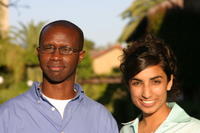 Two years had passed since my thesis was given an award at graduation— this is the last time I saw my advisor. So as soon as I walked through the door, Joseph and I (pictured) chatted endlessly about all that had passed—from current events to my academic plans to his new position as dean. And then when our conversation turned to America’s present climate from a social psychological perspective, we simply moved to our spot before the camera and began rolling.
Two years had passed since my thesis was given an award at graduation— this is the last time I saw my advisor. So as soon as I walked through the door, Joseph and I (pictured) chatted endlessly about all that had passed—from current events to my academic plans to his new position as dean. And then when our conversation turned to America’s present climate from a social psychological perspective, we simply moved to our spot before the camera and began rolling.
Joseph described how widespread fear and anxiety cause the public to permit state policies and actions (like the Lodi case) that would not have been tolerable before. Even if those actions are ineffective.
Fear is at the center of the social psychology of prejudice, both in the motives for prejudice and its long-term impact on targeted communities. For example, one concept to explain prejudice is terror management theory: when people feel threatened, they are more likely to discriminate against anyone who is not ‘seen’ as part of their ‘group.’ One can imagine that terror management happened on a national scale after 9/11. Not only were Sikh, Muslim, and Arab Americans already not ‘seen’ as full-fledged American citizens, media images confirmed their faces as those of the ‘enemy.’ This made it easy for people to target them based on how they looked.
What about the impact of prejudice? In the short term, targeted groups respond by withdrawing from public spaces, both physically and mentally. In the long term, people experience stereotype threat: Every time targeted Americans enter a public space, like airports, they are aware of the stereotypes against them, now embedded into American culture, and this increases their own anxiety. In many cases, people experience attributional ambiguity: when others treat them poorly, they are left guessing whether the motive was prejudice or not. In the end, entire communities of people feel marked in public spaces in mainstream America.
In the end, both Joseph and Jayashri offered frameworks for understanding the stories of prejudice and profiling in Lodi and across the country. This confirmed my faith that academia may pro
vide both theoretical and practical responses to social injustices. (This is why I am still in school and will be for a long time, now at Harvard Divinity, next fall at Yale Law School).
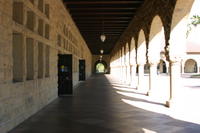 As the crew packed after the interview, I walked through Stanford’s Main Quad (pictured) and remembered all the hours I spent walking these halls, researching and reflecting on the stories gathered on my journey across the country after 9/11. Now I am back, this time with a film crew. I would have never imagined that a student project could have grown into a feature-length independent film production.
As the crew packed after the interview, I walked through Stanford’s Main Quad (pictured) and remembered all the hours I spent walking these halls, researching and reflecting on the stories gathered on my journey across the country after 9/11. Now I am back, this time with a film crew. I would have never imagined that a student project could have grown into a feature-length independent film production.
 To add to the nostalgia, my dear friend JESSICA JENKINS (pictured) showed up to meet us. We had been dorm-mates together since freshman year all through college, both studied International Relations, and wrote our honors theses side by side. (She wrote about women in El Salvador and Catholic liberation theology). Now Jess is working for a Catholic social justice lobbying group in DC, but we still collaborate together. She is working on this film as Director of Research, for example.
To add to the nostalgia, my dear friend JESSICA JENKINS (pictured) showed up to meet us. We had been dorm-mates together since freshman year all through college, both studied International Relations, and wrote our honors theses side by side. (She wrote about women in El Salvador and Catholic liberation theology). Now Jess is working for a Catholic social justice lobbying group in DC, but we still collaborate together. She is working on this film as Director of Research, for example.
 Jess and I walked together and visited my favorite men at Stanford: the Burghars of Calais (pictured). They were my companions in despair and struggle and strength when I was a student here. The crew filmed them alongside Memorial Church and the Main Quad, in order to capture Stanford as the starting point of the journey.
Jess and I walked together and visited my favorite men at Stanford: the Burghars of Calais (pictured). They were my companions in despair and struggle and strength when I was a student here. The crew filmed them alongside Memorial Church and the Main Quad, in order to capture Stanford as the starting point of the journey.
Stanford University was the first to give me a small grant to make the trip across the country. I only needed a few thousand dollars then to make the four-month trip, taping interviews on a video camera. Now four years later, in order to complete this feature-length movie and aim for theatrical release, we need $40,000. Help us make it happen.
A big thank you to our friends: Mohammad Abdul-Carim, Kulwindor Dol, Amit Garg, Chris Metinko, Sonya P, and Vijay Myneni and Jagu (who just got engaged!). They joined us for dinner after our long production day, and gave us food, drink, music, and even donations for the project. Too much.

